
.
All content included on this site such as text, graphics and images is protected by U.S and international copyright law.
The compilation of all content on this site is the exclusive property of the site copyright holder.
UPCOMING The Tulip Garden Polly Nicholson in conversation with Lindsey Taylor will be exploring her passion for tulips
at the Mertz Library Reading Room of the New York Botanical Garden on June 13, 2024 from 10:30 a.m. - 11:30 a.m. EDT
Session Number: 244GAR851, Non-member registration $39 / Member: $35 Book signing to follow.
.
Even more exciting, she will guide a 2 hour workshop, Potting Seasonal Bulbs, Session Number: 244GAR544,
Watson Room 101 Non-Member (Includes Materials): $390.00 / Member (Includes Materials): $360.00
.
Phone: 718.817.8720 to register or more information.

What tulips do you, perhaps, grow in your garden. Planted in the autumn, flower in the spring . . . and in subsequent years send up a single, outsized, "rabbit ear" leaf and no flowers. Readily available, popular choices are cultivars with large flowers. discarded after flowering, planted fresh every fall, rather like the equivalent of summer annuals but with an odd growing cycle.
There are some gardeners who enjoy dwarf plants that perennialize in a rock garden. Selected for their modest size, these are tulips that thrive in those gravel-rich, low fertility, quickly draining sites, similar to their native haunts of steppes and mountainous areas.
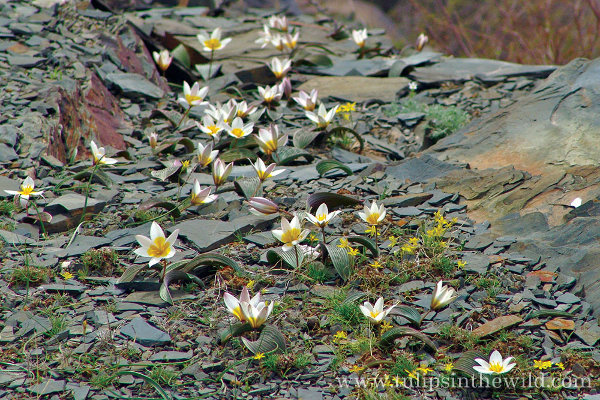
image courtesy Eric Breed, Tulips in the Wild
Quite rare, Tulipa regelii is native to southeast Kazakhstan where it grows only in certain
dry, rocky areas of the Chu-Ili Range, a northern subrange of the Tian Shan mountains.
Today, fascination with tulips is a different matter for Polly Nicholson, holder of the UK's National Collection of Tulipa (Historic). An organic flower grower in Wiltshire, UK, she has been growing species, historic and also annual garden varieties of tulips, for over fifteen years.
The Tulip Garden: Growing and Collecting Species, Rare and Annual Varieties
by Polly Nicholson, photography by Andrew Montgomery
a book review
Friday, 7 June 2024

image copyright Andrew Montgomery, provided courtesy Phaidon Press
In her newly released debut book, The Tulip Garden, Nicholson presents a beautifully illustrated tribute to tulips.
Polly Nicholson has an enclosed 6 acre garden at their family home in Wiltshire. Walls of brick and ashlar to the north and east, weathered estate railings to the west (which provide a barrier to the flock of Hebridean sheep), while the River Marden creates a natural boundary to the south. In this enclave she has developed and established naturalized plantings of species tulips, containers of historic varieties (more about them later), and perennial plantings of those cultivars that are reasonably reliable about flowering year after year.
Where does a passion (in this case, for tulips) begin. With quantities of annual (or garden) tulips for Bayntun Flowers, her cut flower business. In 2015, her head gardener noticed an historical tulip for sale in a mainstream catalog. Bought on a whim, when 'Dom Pedro' flowered the following spring, Polly was - in her word - bewitched. She searched for others. She visited the Hortus Bulborum in Limmen, The Netherlands.

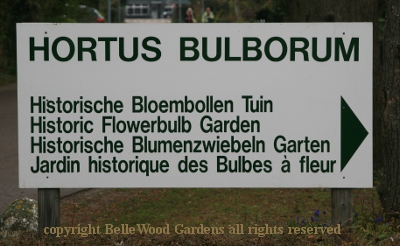
Over the next five years a collection was assembled, a nexus with a focus on Dutch Historic tulips from 1595 to contemporary times, and a subsection of English Florists' tulips of the nineteenth and twentieth century. Polly joined specialist societies as members have access to these rare bulbs which are not commercially available. There are annual shows, with two sections: the breeders, which are plain and solid color. And broken also known as Rembrandt tulips, with the highly desirable feathered and flamed patterning.

image copyright Andrew Montgomery, provided courtesy Phaidon Press
By 2021, Polly shares with us, her readers, she had amassed a collection of about seventy-five different varieties of these historical tulips. And decided to apply for National Collection of Tulipa (historic) status with Plant Heritage. Her interest in these bulbs has not waned. If anything it has grown. She opens her garden through the National Garden Scheme in April and May. A fascinating story, with more details. Which you can learn about in her book.

image copyright Andrew Montgomery, provided courtesy Phaidon Press
As her interest in these rare and historic tulips has increased, that of the annual tulips has waned. Needing reordered each year, to be sold as cut flowers or in a container. Reluctantly, because Polly prefers to grow organically and commercial bulbs rarely are so produced, she still uses them, choosing cultivars less commonly available and only growing in the low thousands, to be lifted, dried, then replanted in rough grass banks afterwards to adapt to life in the wild.

image copyright Andrew Montgomery, provided courtesy Phaidon Press
This opening chapter of The Tulip Garden interested me, presenting as it does the why and wherefore of Polly Nicholson's fascination with tulips. And not just any tulip, but the wild species, the historic cultivars, and then - oh yes - the tulips treated as annuals. For it is in the rest of the book, its well illustrated greater portion, that the bewitching diversity of tulips is laid out in detail. Description of individual tulips are accompanied by a single, individual cut flower in a vase, bottle, or some sort of container. One thing you might want to keep in mind is that tulip stems continue to grow, to lengthen, even when cut.

image copyright Andrew Montgomery, provided courtesy Phaidon Press
Wishing to display the tulips to their best advantage, the Dutch invented tulipieres
specialty tulip vases pyramidal in outline with multiple spouts for individual tulips.
Of course the originals were Delft blue. Today, one in pink. Some even made of glass.
Having described the how and why she became enamoured with tulips, in the next section of her book Polly Nicholson now explores and explains how to grow, maintain, and care for the diversity of species, also called botanical tulips. For example, dead heading as their flowers fade is her practice for all except Tulipa sylvestris. These are the wild ones, which have in some instances had cultivars selected and developed.

Tulipa clusiana 'Tinka' at the New York Botanical Garden's Everett Rock Garden is just such an example.
Suggestions are provided for cultivating these gems of the tulip world in the garden and also in containers, photographed in both settings. A modest selection of species and cultivars are discussed and illustrated, each photographed as a handful of cut flowers dropped on paving stones.
Chapter II brings us to the Blacklands collection of approximately a hundred different rare and unusual historical Dutch tulips from the late sixteenth century up to the present day. 'Breeders', we should remember, are those plain, solid, self colored flowers. 'Broken' or Rembrandt tulips are this where what were originally solid are now feathered, flamed, streaked with a contrasting color. Sensibly, this section begins with the breeders, with discussion of twenty or so.
Just as five centuries ago, the broken, Rembrandt tulips that enthralled painters and speculators bring admiration today. The dozen cultivars described here are each one unique. There is mention of a few broken tulips that have seemingly become immune to the weakening effects of TBV (tulip breaking virus.) And every season a few other tulips that weaken, diminish, and eventually disappear.
There is a separate section here, devoted to the 'Duc van Tol' tulips, some of which were grown by Carolus Clusius in the sixteenth century, in what is today known as the Clusius Garden, part of the Hortus Botanicus in Leiden across the canal from the University's botanic garden.

image copyright Andrew Montgomery, provided courtesy Phaidon Press
Seen here is Tulipa 'Duc van Tol Red and Yellow' on the left, dating back to around 1595.
And on the right, an example of intensely scarlet 'Duc van Tol Scarlet', registered in 1850.
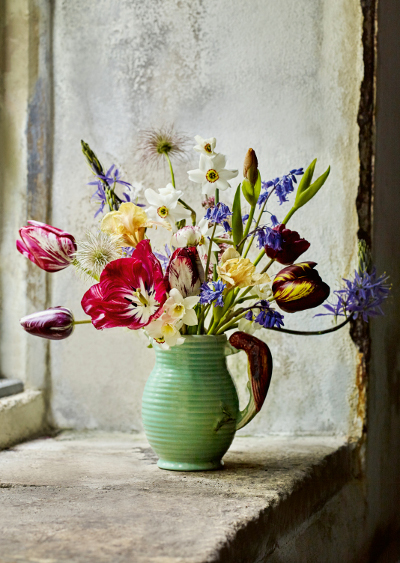
image copyright Andrew Montgomery, provided courtesy Phaidon Press
In a jug on a deep windowsill, a mixed bouquet of broken tulips, a few narcissus, and scilla.
Chapter III brings us to the English Florists' Tulips. This chapter explains the definitions of the various terms and categories, and dives more deeply into eighteen cultivars in Polly Nicholson's collection.
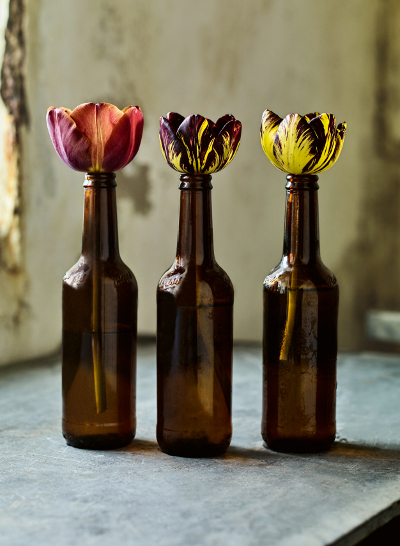
image copyright Andrew Montgomery, provided courtesy Phaidon Press
Here is a wonderful illustration of 'James Wild' in all three stages - breeder, flamed, an feathered.
Enough? No, The Tulip Garden has yet more information and lovely images to share with its readers. Chapter IV takes a deep dive into what Polly Nicholson names as Annual Tulips, planted in the fall for cutting when in flower in the spring. Then lifted, dried, and replanted in rough grass to grow (or not) as might be. Thorough discussion with accompanying photographs, a calendar of what should be done when. Do keep in mind that Blacklands is in Wiltshire,UK, equivalent of USDA zone 8, and climactic differences from where we might be gardening.
Whether, having read and enjoyed this delightful book, you become as hypnotized
with historical tulips or simply want to enjoy flowers from your garden, come fall
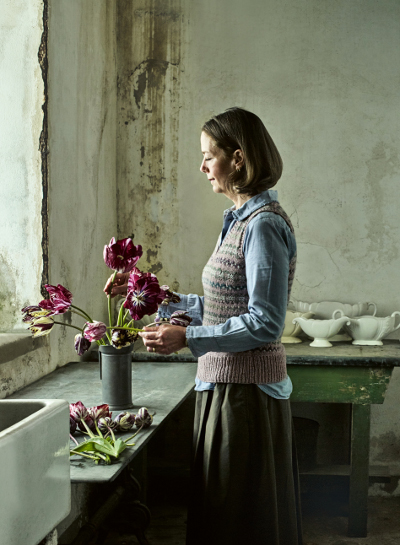
image copyright Andrew Montgomery, provided courtesy Phaidon Press
plant some tulips (and other bulbs) so next spring you can bring their beauty home.
The Tulip Garden
by Polly Nicholson
photography by Andres Montgomery
published by Phaidon
ISBN: 978 1 83866 768 9, hardcover, $39.95
A review copy of this book was provided by the publisher
Back to June
Back to Book Reviews-2024
Back to the main Diary Page